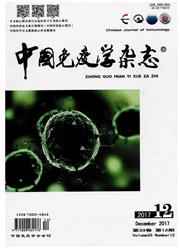

 中文摘要:
中文摘要:
目的:用负载EB病毒抗原LMP-2表位肽段的鼻咽癌患者树突状细胞(DC)诱导自身CD8^+T细胞,观察其细胞毒性T细胞的免疫应答能力。方法:在体外分离并诱导成熟HLA—A2基因型鼻咽癌患者自身的DC,分别负载EB病毒抗原LMP-2的HIA—A2限制型两个表位肽段CLGGLLTMV(CLG)和LTAGFIFL(LTA)后,诱导自身CD8^+T细胞,培养2周后,运用酶联免疫斑点法(Elispot)和HLA-肽四聚体法(Tetramer)检测诱导后T细胞的免疫应答情况。结果:经DC抗原呈递后分泌IFN-γ的CLG和LTA特异性CD8^+T细胞数,分别为(42.67±33.79)个/孔和(25.67±18.25)个/孔,而呈递前分别为(2.67±1.97)个/孔和(5.33±1.86)个/孔。两者IFN-γ^+CD8^+T细胞数均有明显增加(P〈0.05)。CLG和LTA肽段特异性细胞毒性T细胞(CTL)的中位数在呈递前分别为0.135%和1.14%;呈递后则为1.045%和1.945%。两者较呈递前均明显增加(P〈0.05)。结论:负载EB病毒抗原LMP-2表位肽段的DC诱导鼻咽癌患者自身CD8^+T细胞,可产生特异性CTL,对鼻咽癌患者的免疫治疗具有潜在的应用价值。
 英文摘要:
英文摘要:
Objective:To study the immune response of CD8^+ T cell from HLA-A2^+ patients with Nasoparygeal cancer( NPC), induced by autologous dendritic cells ( DC ) loaded with HLA-A2-restricted epitope peptides from EBV latent membrane protein 2 ( LMP- 2). Methods: Get DCs by culturing plastic-adherent monocytes isolated from NPC patients of HLA-A2^+ peripheral blood with cytokine. Stimulating autologous CD8^+T with DCs pulsed with the peptides CLGGLLTMV(CLG) and LTAGFIFL( LTA), the HLA-A2-restricted epitope poptides from LMP-2 protein. After 2 weeks for culture, frequencies of CD8^+ T cells to secret IFN-garmma in response to peptides were detected by Elispot assay and peptide-specific CD8^+T cells were measured by tetramer staining. Results :The frequencies of effector cells to secrete IFN-gamma in response to CLG and LTA before DC presentation were (2.67 ± 1.97)/well and (5.33 ± 1. 86)/well, respectively. After DC stimulation, the number was (42. 67 ± 33.79 )/well and (25.67 ± 18.25 )/well respectively. They all were increased significantly after DC presentation( P 〈 0. 05 ). The median frequencies of CLG-specific CD8^+ T cell and LTA- specific CD8^+T cell were 0. 135% and 1. 140% respectively before DC presentation; after presenting they were 1. 045% and 1. 945% respectively. The frequencies of the two specific CD8^+ T cells were enhanced significantly after DC stimulation ( P 〈 0. 05 ). Conclusion:The DC loaded with the epitope peptides of LMP-2 from EBV can induce CD8^+T cells to cytotoxic T lymphocytes(CTLs) , with clinical potential for immunotherapy.
 同期刊论文项目
同期刊论文项目
 同项目期刊论文
同项目期刊论文
 期刊信息
期刊信息
